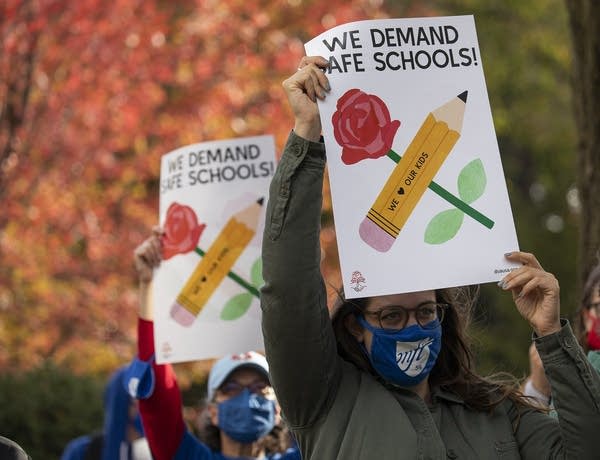It’s back to school — again — for many of Minnesota’s youngest students
Meanwhile, districts scrambling to implement new state plan to vaccinate limited number of school staff

Go Deeper.
Create an account or log in to save stories.
Like this?
Thanks for liking this story! We have added it to a list of your favorite stories.
Thousands of Minnesota elementary students will be on their way to school Tuesday morning — some of them seeing their classrooms in person for the first time ever.
The mere presence of the state’s youngest learners in physical school buildings is again shifting the picture of Minnesota education in the middle of a pandemic. And the changes come at a time when Gov. Tim Walz is launching a pilot program aimed at getting a limited number of teachers vaccinated.
State officials have moved school staff and child care workers up in the line of prioritization for receiving the COVID-19 vaccine. On Monday, Walz announced nine pilot sites would be set up to start administering the vaccine to school and child care workers, in some cases as soon as Thursday.
But a very limited supply of these vaccines are actually available for school workers this week — in some districts, between 1 and 2 percent of staff will get this first round of vaccine, so administrators were instructed to make lists of which staff to prioritize.
Turn Up Your Support
MPR News helps you turn down the noise and build shared understanding. Turn up your support for this public resource and keep trusted journalism accessible to all.
Many educators are worried about being exposed to the virus. Minneapolis and St. Paul teachers have been staging demonstrations to express their concern that schools are opening too soon, before more teachers have been vaccinated and without more safety measures.
Ed Barlow, a band teacher in Minneapolis Public Schools, said he is worried about the potential for viral spread in his classroom.
“We’re on the cusp of receiving the life-protecting vaccine that will give us all a chance of staying healthy,” he said at a virtual news conference Friday hosted by the Minneapolis Federation of Teachers. “Why are we pushing so emphatically toward reentry into an environment that cannot possibly be secured well against this threat?”

Shifts in learning
Many schools had pivoted to remote learning amid a spike in coronavirus cases around Thanksgiving. Among the districts in the Twin Cities metro area resuming in-person instruction this week are Anoka-Hennepin, Osseo, White Bear Lake, Robbinsdale, Farmington and Hopkins.
Other districts, including Minneapolis, St. Paul, Mounds View and others, are bringing elementary students back starting later this month or next.
It’s a big departure from where Minnesota schools were even just a few days ago. As of late last week, fewer than 15 percent of public kindergartens in the state were offering in-person learning. And in the Twin Cities metro area, that number was closer to 2 percent.
The resumption of in-person learning was made possible after Walz last month told elementary schools that starting this week, they could phase in the return of their youngest students, regardless of the COVID-19 case rates in their county.
Since July, all public elementary schools have had to consult with local health officials on the amount of virus spread in their communities before deciding whether to do distance, in-person or hybrid learning. Now that’s no longer true for kindergarten through second grade, and in a few weeks, these new rules will apply to all elementary students.
School staff are approaching their return to the classroom with a mix of excitement and anxiety.
‘We want them learning’
At Robbinsdale Area Schools, about a third of the district’s elementary students have chosen to continue in distance learning, said Marti Voight, the interim assistant superintendent. But the district is also welcoming back some kids Tuesday who have never been in their school buildings before.
“We want our kids back in school. We want them in front of us, we want them learning,” Voight said. “But then the next thing that came in was worried, being anxious, being nervous — all the things that I think you have at the beginning of the school year, but this is on top of now you have COVID to consider.”

Since Walz’ announcement, new national studies have explored whether in-person learning is driving the spread of COVID-19. A study out of Tulane University found hospitalizations did not go up when schools welcomed students back in person — as long as hospitalization rates were already relatively low.
But that pattern didn’t hold true for places where the spread of COVID-19 was already high. In those areas, researchers found examples of open schools making things worse.


